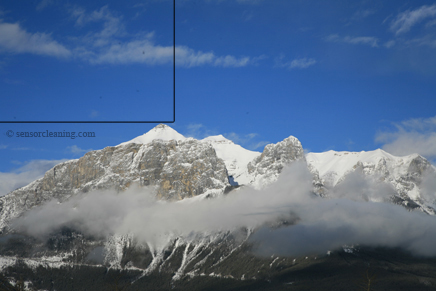Why (Do I Have Debris On My Sensor)?
Unfortunately, if you are the owner of a digital SLR camera, it is inevitable that you will find unwanted anomalies in your images. These blemishes usually show up as blurry to black circles or squiggles and come in a variety of sizes. If you spot these irregularities in numerous snapshots, within the same region of each image, your digital imaging sensor has accumulated debris. This debris can be subcategorized in one of two forms: ‘dry’, most commonly dust or lint, or ‘wet’, from moisture accumulation or lubricant transfer.

First and foremost, to set your mind a little at ease, the debris is not on your sensor per se, but is resting on top of the low pass filter or optical glass that covers your sensor. But even still, the filter is highly sensitive and great care should be taken to not mar or scratch the surface.
There are many different reasons why debris may have accumulated inside the camera chamber. One of the most prevalent is frequently changing the camera lens. Any time that you remove a lens and replace it with another opportunities arise where dust may fall directly in, be attracted by subtle static build-up, or be clinging to the lens that you just put on. This may not be detected immediately, as it may take some time for the debris to make its way to land on the filter. Debris can be shifted around by the brisk movements of the mirror and shutter, shuffled by atmospheric changes, or disturbed by rigorous movement incurred in travel. Care should always be taken when storing both the camera and lenses so that they are not introduced to dust. When changing lenses, make sure that everything is readily available so that the camera chamber is exposed for the least amount of time and that all components are as contaminant free as possible.
This brings to note, that some people have reported never changing their lens and have come to find that their images contain blemishes after time. Again, travel, mechanical motion, atmosphere and other factors can cause debris that was present in the chamber area at the time of manufacture to set on the filter.
Accumulation of water vapour due to humid climates is another factor that may affect the image quality produced by your camera. Water may collect and cool on your sensor filter, eventually evaporating, leaving a stain from the deposits left behind. It has been noted that on occasion a dust particle will be present as well, adhering the dust particle to the filter making it much harder to remove.
The various moving parts of the camera cause friction, so to reduce erosion of these parts, lubricants are used. These lubricants, while minimal, can pose a problem if transferred onto the camera sensor causing a ‘smear.’ Due care and attention should be noted when removing lenses and cleaning within the chamber area, so as to not spread any lubricant over the sensor filter.
As a last comment, it should be said that is a bad idea to touch the sensor filter with your fingers, as there are natural oils that will be transferred onto the filter which again are rather difficult to remove as opposed to dust.
